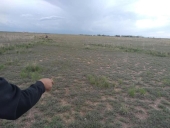Snow fences are a great way to grab valuable moisture from the wind. Many dry places get the bulk of their precipitation as snow in the winter. Snow is not distributed evenly over the landscape. The leaward side of hills receive more snow than the windward side gets. On open plains, much more snow accumulates in wooded gullies, in river valleys and in shelter belts. These structures collect snow and they block winds that would blow the snow away again.
How to work hugelkultur into this.
Long mounds laid perpendicular to the prevailing winter winds, could be used to gather snow within the little valleys between parallel mounds. If the ends are sealed with soil, all snow melt would percolate into the soil and no runoff could occur. I imagine elongated ovals where the long sides face the wind. The inner trench could be completely filled. Drifting snow naturally finds a level.
I imagine that the bulk of the wood in this system should be buried in the valleys. So it's pit hugelkultur. The mounds are summer windbreaks and winter water traps. The valley bottoms will receive much more water than would naturally be deposited in that spot, wind would be blocked and the wood core stores the water. Plants that require less moisture could be grown on the upper slopes. Bushes, trees and any plant that leaves a wind blocking stalk after harvest, would trap snow. A shelter belt to the leaward side of the beds would help to make snow precipitate. I could see planting Jerusalem artichokes at the base of each mound on the windward side. Spring runoff will favor this area and the dead stalks will work as a snow fence, to slow the wind just before the valley.
I created this thread a while back. The ideas are related, and some of the ideas from there, could apply to this.
Rubble Rock Fog Wall in a Swale https://permies.com/t/31304/desert/Rubble-Rock-Fog-Wall-Swale
I get far too much rain for this to be tried at my place. I am hopeful that someone who lacks adequate precipitation will give this a try.
Thank you: Dale

























 1
1














